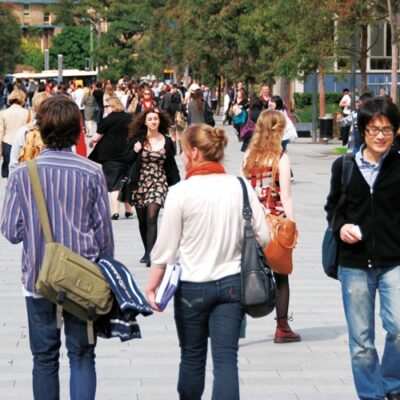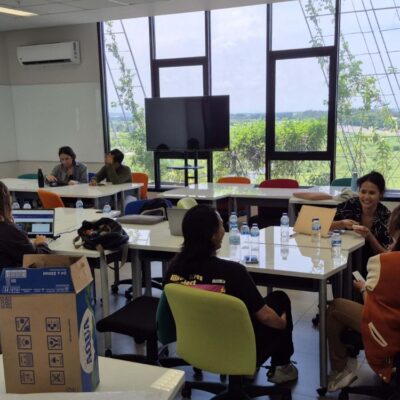In Australia, English is an additional language or dialect for one in four school students. The importance of maintaining a home language for such students is recognised in the Australian Curriculum not only for their English language learning, but also for preserving and developing their cultural identities and family relationships.
Japanese is one of the top three languages studied in Australia, but learners of Japanese as (a) community language (JCL) have been a minority in Japanese language classes in Australia.
As a minority, their diverse backgrounds, needs, abilities, and issues surrounding them tend to be overlooked or dismissed in classrooms and at the policy level. However, gradually but steadily, their increasing presence has become no longer unusual in major cities and presents a new challenge and opportunity to those involved in policy making and Japanese language education.
What is KEISHOGO?
KEISHOGO (繋生語: community language) is defined as the language that is born from connections with parents, family, and friends, that creates further connections, generates new meanings, and passes these connections on to the next generation: and a language that is used in and evolves through contact with the Japanese-speaking community.
It is contrasted with Keishogo (継承語: heritage language) since ‘heritage’ excludes those without a blood relationship such as international adoptees or children of ethnic minorities in Japan whose home language is Japanese since their parents are native Japanese speakers whose ethnic language proficiency is lost or limited.
Furthermore, KEISHOGO aims to be more inclusive and empowering to those involved in JCL education, better reflecting the reality of bilingualism/plurilingualism, and in line with the use of the term ‘community language’ in Australia and New Zealand instead of ‘heritage language’ which is commonly used in North America and elsewhere.
This article reports on findings from a nation-wide interview-based study conducted by the Australian Network for Japanese as Community Language (ANJCL) in which the authors of this article represent the Victoria branch. It also reports on findings from the authors’ own studies on teenage or young adult JCL speakers. More specifically, we will discuss their diverse characteristics, learning experiences and the challenges they face, and make suggestions to empower both learners and teachers.
Challenges faced by JCL learners
Members of the Australian Network for Japanese as Community Language have been actively engaged in research activities that help promote better understanding of JCL and development of supportive KEISHOGO communities. They include three surveys in Australia on the Japanese language learning environment for speakers of Japanese as community language. This research shows that 90 percent of the JCL learners in this study (241 parents responded to the surveys) were born in Australia or migrated to Australia when they were below the age of five. Most were children of a Japanese mother and an Australian father and often used Japanese in family communications. However, this study and others also found that JCL learners are significantly diverse in terms of the degree of familiarity with Japan, Japanese language proficiency, educational background and direct experience (e.g., community language school attendance, schooling in Japan, etc.), sense of ethnicity and belonging to Japanese-speaking communities.
*Rika (a pseudonym) is a participant of Naomi Kurata’s 2015 study who had lived in five Asian countries, including Japan, with her Japanese parents at the time of the study. She was enrolled in an upper intermediate level Japanese course at an Australian university. She described the diverse linguistic background of her family: ‘Mum and Dad can speak both English and Japanese. Mum can also speak Portuguese. Dad can speak Cantonese. It’s weird. I wish they had chosen one language [to use at home]’. She further explained that her father and her grandparents tried hard to speak Japanese with her although her mother gave up on doing so and spoke only English to her. She expressed her frustration about her linguistic history: ‘It’s a bit strange, it’s not FAIR that I don’t know what my first language is (Capital letters show her emphasis)’. This is the case with many JCL learners due to the complexity and diversity of their linguistic and cultural backgrounds background. However, one common feature is that they are not monolingual native speakers of Japanese.
Regarding her sense of connection to Japan and the language, Rika stated: ‘When I go back (to Japan), I don’t feel Japanese, I feel strange […] that’s why I am studying Japanese very hard. .. The only thing that keeps me connected to Japan is my PASSPORT. I don’t WANT that.’
It is clear that she considered herself to be an outsider in Japan, but she believed that knowledge of Japanese was important for maintaining a connection to Japan. This sense of attachment to the language could be a strong motivation for her to continue to study Japanese.
Rika also expressed how she felt about herself and her peers in a Japanese classroom setting:
‘I don’t see myself at an advantage, I really don’t, like there are people in my (Japanese) class who can speak and read better and much easier than I can, and sometimes I sit there thinking “I don’t understand this.” […] it’s embarrassing, BUT I wanna be able to progress.’
As other research shows, members of language classrooms, including teachers and non-JCL classmates, tend to position JCL learners as ‘experts’. Contrary to this positioning of JCL learners, Rika seemed not to consider herself as advanced in her skills as other students.
As shown in Rika’s case, JCL learners at tertiary level have significantly complex and diverse backgrounds, and they thus have different learning needs from those of non-JCL learners. Due to this difference, JCL learners may end up frustrated in a beginner class because of the lack of advanced courses or they may be embarrassed in a higher-level course where classmates and teachers place high expectations on their typically weaker literacy skills. Therefore, overestimation of ability is a critical issue for JCL learners, and this can lead to a lack of awareness in relation to the challenges they face and may lead to disappointment when personal expectations are not met. When combined with JCL learners’ stated feelings of pressure to perform well, these issues can result in students dropping courses or losing critical self-esteem.
Issues that JCL learners face in learning Japanese appear to be most problematic at school, especially at senior secondary level, as the following cases show. While we are unable to verify the accuracy of the accounts by *Ai and *Ben (pseudonyms) in the state of New South Wales (NSW) (Australia’s most populous state) who participated in Kaya Oriyama’s study and those by *Chika (a pseudonym) in Victoria (Australia’s second most populous) in the ANJCL’s 2022 study, we cannot dismiss the fact that their accounts are the reality to them (like the majority of JCL learners, all Australian-born except for Ai who arrived in Australia aged 12 months).
Ai recalls of her Australian primary school Japanese classes: ‘My teacher was Japanese, but I didn’t receive encouraging feedback even when I did well (unlike my non-Japanese classmates).’ Having her home language offered at school could have been a positive experience, but she felt that her Japanese ability was taken for granted without such acknowledgement. It should be noted that her Japanese ability is not something that should be taken for granted since our studies and other research found that it is not unusual to find children who grow up in Australia and speak to their Japanese parents in English.
Ben’s Japanese language teacher allowed him to study Japanese Continuers (a mainstream course between Beginners and Extension) during his final years of secondary school (Years 11 & 12), but when he was finishing Year 11 Japanese, his school principal told him that he was not allowed to continue because he had an ‘advantage’ (his mother spoke Japanese with him) that the principal deemed to disqualify his course entry. As a result, Ben had to take a different non-language subject and found it hard to catch up with his Japanese study at university.
Chika was told that she could not study with her school’s Japanese-as-a-second-language class and that she had to self-study in the library after her teacher found that she could recognise (but not read or write or use in context) the listed kanji (Chinese characters adapted to Japanese) for Year 12 level that had not yet been covered in class. She eventually found a way to study Japanese at senior secondary level through organisations outside her school, but she had to commute and study on weekends.
It would not be surprising if these JCL learners felt like misfits or outcasts due to such experiences. Would the same happen in other subjects? Would you not praise all your students when they do well? Would you disqualify students from a music course if their parents are musicians? Would you exclude students from a maths class if they knew algebra already when you have not taught it yet?
What’s behind the exclusion and positioning of JCL learners?
In the final two years of senior secondary school, students can learn a language from over 40 languages offered as subjects, which vary between each state and territory. Their availability and access to appropriate courses matter, as their successful completion and total scores (from Years 11–12 internal assessments and Year 12 external final end-of-school exams) are counted towards the final scores that determine students’ future; whether they can graduate, and which universities and courses they can enter.
However, unlike other languages, the ways nationally strategic Asian languages, including Japanese, are offered and accessed at senior secondary school mean that JCL learners could be perceived to be at an advantage and even excluded from such a high-stakes subject.
For example, for nearly 15 years until Term 3 last year, JCL learners in NSW like Ben were ineligible to take the Japanese Continuers course for the Higher School Certificate (HSC) if they use Japanese for ‘sustained communication outside the classroom with someone with a background in using the language’. Yet, the assumption that such communication always leads to a higher language proficiency than the course level was not backed up by research. Moreover, what was meant by ‘sustained communication’ was unclear, as ‘it cannot be measured and is open to interpretation’ usually by the principal and the eligibility criterion initially introduced in 2001 has become stricter over the last two decades.
Similar criteria existed in several other jurisdictions (South Australia, Northern Territory, Tasmania, and Western Australia (WA)), and the issue has prevented many JCL learners from taking the course at this level and learning Japanese altogether during senior secondary school where no other suitable course is available. Furthermore, despite a concern behind the criteria that their presence in the course may deter other students from taking it, the exclusion did not lead to increase in its Year 12 enrolments.
In contrast, final year Japanese enrolments have remained high and stable in Victoria where the criteria have not excluded those educated mainly in Australia and incentives to take languages (e.g., bonus Australian Tertiary Admission Rank points that facilitates university entrance) have been given. Although most states and territories now exclude only those educated in Japan (albeit strictly, typically for more than a year at any year-level) from Continuers-level courses, the issue still persists in WA because the problematic eligibility criterion similar to the one abolished in NSW remains.
After many years of the divisive practices of excluding JCL learners from mainstream upper secondary Japanese courses despite their diverse language proficiency and backgrounds, it seems that their perceived illegitimacy and ‘unfair advantage’ may have become normalised and problematised among some, as manifested in the JCL learners’ negative experiences discussed above.
Looking ahead: JCL learners as assets
Some JCL learners in our ANJCL 2022 study and Oriyama’s 2021 study had positive and empowering experiences learning Japanese at school and/or university. Some studied in Japan on school or scholarship at university and improved their Japanese significantly in doing so. Others who stopped speaking Japanese after entering primary school regained their ability to speak it and acquired a high level of literacy after studying at senior secondary school and university. This enabled them to better communicate with their Japanese parents as well as relatives in Japan, and belong to various Japanese-speaking communities including those formed with their classmates who shared similar interests in Japanese language and culture. Moreover, these experiences led them to embrace their multiple identities, helping them resolve identity conflict. For these students, learning Japanese resulted in positive changes to their lives.
At federal level, the Australian Curriculum prioritises Australia’s engagement with Asia and supports the learning and teaching of Asian languages. Yet, educational policy is implemented differently by each state and territory government and there is a lack of coordination and consistency among them. Removing the most problematic eligibility criterion in NSW was a welcome change that set a precedent to follow, finally allowing many JCL learners to study at or around appropriate levels and for intercultural understanding to occur in class and at school. This might at last lead to overall increase and higher retention in senior secondary enrolments in NSW and bring about positive changes.
We argue that it is through the inclusive teaching and learning of languages that can truly promote intercultural understanding and social harmony among students and the wider community. As a successful case in the Early Learning Languages Australia (ELLA) program shows, JCL learners need to be recognised not as problems but assets; although they are neither ‘experts’ or unfairly ‘advantaged’, each with unique strengths and learning needs, they can contribute to this process in various ways. At the same time, their knowledge and skills can be strengthened with blended learning using technology/group work and their needs recognised by sharing their experiences as part of teaching. JCL learners are diverse but legitimate learners and integral members of Australian society. They have the potential to become a bridge between Japan and Australia inside and outside the classroom. This should be developed to the fullest.
*Pseudonyms are used throughout
Authors: Dr Kaya Oriyama and Dr Naomi Kurata.
Image credit: Photo by note thanun on Unsplash




